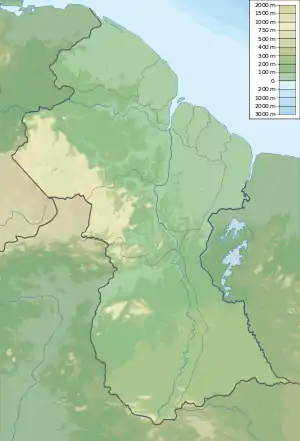Takutu Formation
The Takutu Formation is a Late Jurassic geologic formation in Guyana and northern Brazil. The formation comprises sandstones deposited in a shallow water to littoral setting.[1] Fossil theropod tracks (a type of dinosaur) have been reported from the formation.[2][3] A paleobotanic analysis of drill cores of the formation was conducted by Thomas van der Hammen in 1966 and showed fossil Classiopolis flora.[1]
| Takutu Formation | |
|---|---|
| Stratigraphic range: Late Jurassic | |
| Type | Geological formation |
| Unit of | Rewa Group |
| Lithology | |
| Primary | Sandstone |
| Location | |
| Coordinates | 3.0°N 59.7°W |
| Approximate paleocoordinates | 3.2°N 27.4°W |
| Region | Upper Takutu-Upper Essequibo |
| Country | |
| Extent | Guyana Shield |
| Type section | |
| Named for | Takutu River |
 Takutu Formation (Guyana) | |
See also
References
- Berrangé, 1977, p.84
- Weishampel et al., 2004, pp.517-607
- Leonardi, 1994, p.69
Bibliography
- Berrangé, J.P. 1977. The geology of Southern Guyana, South America. Institute of Geological Sciences Overseas Memoir 4. 1–112. Accessed 2018-09-07.
- Leonardi, Giuseppe. 1994. Annotated Atlas of South America Tetrapod Footprints (Devonian to Holocene) with an appendix on Mexico and Central America, 1–248. Ministerio de Minas e Energia - Companhia de Pesquisa de Recursos Minerais, Geological Service of Brazil. Accessed 2019-03-25.
- Weishampel, David B.; Peter Dodson, and Halszka Osmólska (eds.). 2004. The Dinosauria, 2nd edition, 1–880. Berkeley: University of California Press. Accessed 2019-02-21.ISBN 0-520-24209-2
Further reading
- R. B. McConnell, D. M. Smith, and J. P. Berrangé. 1969. Geological and geophysical evidence for a rift valley in the Guiana Shield. Geologie en Mijnbouw 48(2):189-199
This article is issued from Wikipedia. The text is licensed under Creative Commons - Attribution - Sharealike. Additional terms may apply for the media files.